Table of Contents

Growing your SaaS company can be difficult in the early stages. Despite this, you’re sitting in a pretty unique situation compared to other business models when it comes to lead generation.
To grow organically through channels like SEO, SaaS businesses are primed for organic search.
“SaaS or subscription businesses are based on a product that is neither tangible or limited in its use. It can be modified, updated, improved, and pivoted for a variety of cases and industries. Features can be added in order to create new markets and categories and this gives SaaS companies a unique opportunity to compete in the organic search space with SEO.” (source)
In this article, we’ll share 15 hacks to keep in mind when creating SEO content for your startup.
To get the most out of your marketing data, utilizing a tool like Baremetrics makes visualization easy and intuitive. Sign up for a free trial today.
All the data your startup needs
Get deep insights into your company’s MRR, churn and other vital metrics for your SaaS business.
Optimizing images
An easy win on SEO is your page load speed. Page load is significantly influenced by the images on your site, so here are some tips for them:
- Asynchronous image loading is usually done with Javascript.
- Image compression (JPEG Optimizer or Kraken tools) improves your website’s performance and makes the website load faster as images occupy on average 21% of a total webpage’s weight.
- WebP format is a new image format that provides great lossless image compression.
- Adding alt descriptions and title tags is not about loading speed but about better image ranking. The thing is that search bots hardly recognize images, so alternative descriptions and titles help them understand the meaning of an image and rank it better. For better promotion, one can use target keywords in these tags.
Checking meta descriptions
Many marketers underestimate the SEO effect of meta descriptions. They have some significance for both search engines and users. Meta title and meta description can be used for snippets featured in the SERP (but not always, it all depends on the search engine) – and this is what the user sees in the search results.
On the other hand, meta descriptions help search engines understand the contents of a page and what the topic is. Finally, meta descriptions can bring your SaaS business more CTR, traffic, and conversions as if they are included in snippets shown in the SERP.
If you have not filled out the meta description tag, you lose the opportunity to rank higher, get more conversions and revenue. Therefore, it’s better to check your descriptions, optimize them, and check whether they are displayed properly.
Website owners usually use automated tools like a Meta Description Test tool to see whether it’s accurate and engaging. Meta descriptions may include 1-2 target keywords, but using keywords is not crucial for meta descriptions overall.
While doing the check, pay attention to such nuances:
- The meta description should not be too long;
- There should be no keyword stuffing in the meta description;
- The meta description should be relevant to the page;
- The keyword used in the meta description should also be relevant to the topic of the page.

Speaking of keywords, there’s another field in page settings called meta keywords. But it can be simply ignored. Google and Bing do not rely on meta keywords in their ranking algorithms.
Using relevant internal linking blocks
Internal links are crucial for SEO since, with this technique, you can point the search robots to the most critical pages on your SaaS website. Inner linking blocks are links to important sections of your site, collected in one block in some part of the page. For example, in the footer, in the document, at the end of an article, or in a sidebar.
The main advantage of block interlinking is that a beautifully designed block with several links attracts the user’s attention more than a single link in the text:
- the more people who click on a link, the higher the page views;
- the greater its PageRank;
- the more time the user spends on the site, following the links.
All this has a positive effect on the indexing and ranking of the site. Here’s how Asana, one of the leading SaaS businesses, implements this technique:
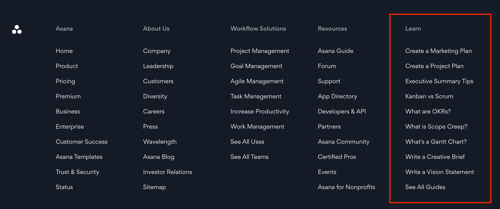
Another technique that may boost your SEO results is dynamic linking blocks. It is a tactic for replacing anchors in linking blocks when the positions for the keywords used earlier have reached the metrics you need.
Requesting crawling for faster indexing
After making changes on a site, it is worth making sure that the search engine robots have indexed the updated content. Re-crawling can take a couple of days or months. Therefore, it’s possible to request crawling to speed up the process a little – here’s an example of how to do it in Google:
- Open Google Search Console.
- Go to the URL Checker Tool.
- Paste the URL of the page into the search bar.
- Wait for Google to display the page information.
- Click the Request Indexing button.

Using best-performing content ideas from competitors
Content is the king for SaaS marketing. First of all, blogs are a great source of organic traffic (if keywords are correctly used). Second, they improve brand awareness and loyalty, helping users better understand your SaaS product, and find answers to their questions.
No one will give you as many ideas for quality content as your highly ranked competitors. So, business consultants advise picking a few related businesses with good content marketing and keep an eye on their publications. A nice service to do this is BuzzSumo, for example. It allows users to collect interesting blogs in one place and keep track of their publications to spot content that brings them the most traffic, engagements, and conversions.
The following metrics should be analyzed:
- Frequency of publications and their topics;
- Keywords used by competitors;
- Content formats: videos, infographics, long reads, etc.;
- Engagements: shares, likes, comments, etc.
Creating content clusters
A content cluster is a way of organizing pages with content, consisting of a parent page, child pages, and the internal links between them.
- The root page acts as a topic hub and contains a high-frequency keyword. It should answer most of the common questions on the topic.
- A subtopic or child page covers a more specific topic and contains long-tail keywords and synonyms.
The content clusters are reminiscent of a TV series, with new seasons and different perspectives on the topic constantly appearing.
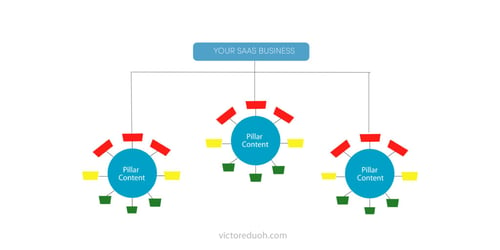
Topic clusters can significantly boost your rankings since they show search engines that all your content is interconnected and provides readers with complete information.
For example, topic clusters brought Grammarly over 20 million active users. This leading SaaS company has a Related Articles section, and the articles there are tied to a specific big topic – for example, tips for beginner writers.
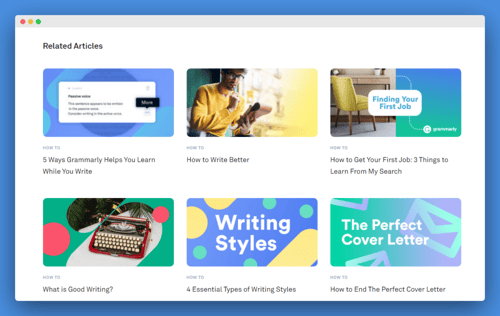
Keeping in mind niche content (Google E.A.T.)
Google’s E.A.T. is for expertise, authoritativeness, and trustworthiness. This algorithm ranks sites higher, providing the most truthful, accurate, and expert information. Google strives to deliver the best and proven content to users.
Due to lots of fake news and SERP manipulations, Google added E.A.T. and YMYL (Your Money or Your Life) requirements to its Search Quality Rating Guidelines. So, now, if your SaaS site doesn’t provide best-in-class content, as well as reliable and accurate data, it won’t be ranked high and won’t bring you conversions.
Sticking to E.A.T. requirements makes sense for all niches, especially if your SaaS business is related to YMYL. These include:
- financial sites (software for financial management, investments, stock exchanges, etc.);
- any kinds of healthcare SaaS projects;
- startups connected with psychology;
- legal sites;
- sites of other projects affecting the health and well-being of users.
Here’s a guide on how to convince search engines of your expertise:
- Making sure you’re qualified enough to give advice, especially on YMYL topics;
- Getting more high-quality backlinks and working with highly-trusted sites;
- Keeping your content up-to-date and accurate;
- Fact-checking all the data that you provide in the content and confirming it with links to authoritative resources;
- Getting more reviews and citations;
- Hiring an expert to create content;
- Creating online profiles for your content writers that will prove their expertise (bios, links to their socials, awards, mentions, etc.).
Optimizing content for rich snippet
Getting to the rich snippet can increase your СTR by 677% and drive much more traffic to your site. As a rule, content that fits search intent the most is more likely to be featured in rich snippets, and that’s good news for SaaS companies. They could target most schema types such as review, how-to, product, video, and FAQ snippets.
For example, let’s suppose that your “how-to” articles match the informational intents of visitors. In that case, your site may get more clicks, longer sessions, and higher conversions (since SaaS companies can easily convert readers of their blog to explaining widespread problems and offering solutions in the articles).
Anyway, it’s always better to be featured in the rich snippet. To get there, it’s advised to:
- Use keywords with rich snippets opportunities – usually, these are long-tail keywords containing words like “how-to,” “what is,” etc.;
- Use structured data markups;
- Add lists and videos to your content page;
- Make short paragraphs with subheadings that answer specific questions.
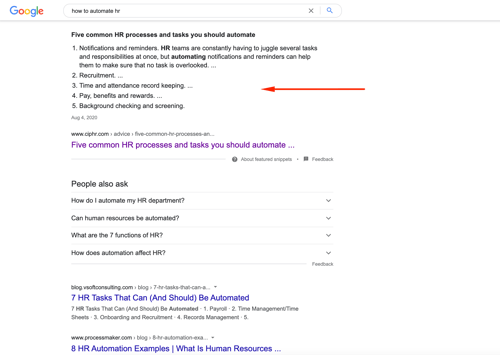
When your content page is updated and extended in a while, it may be featured in the rich snippet. Also, you can run a Rich Results Test by Google whether your page is designed correctly to be shown as a rich snippet to increase chances.
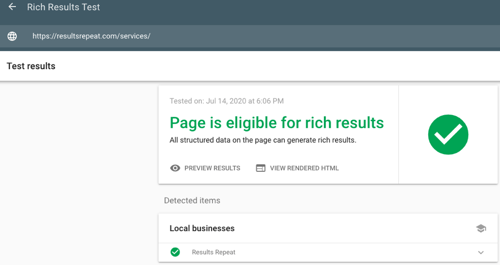
Want to Reduce Your Churn?
History Hit uses Baremetrics to measure churn, LTV and other critical business metrics that help them retain more customers. Want to try it for yourself?
Repurposing content into video format
If you have some great-performing text content (blog article, instruction, guide, etc.), you can present it in a video format. First, it will significantly save time on content creation for the marketing team in your SaaS startup since you already know the hot topics for your audience. Second, repurposing content helps to highlight the main points and reach more people.
According to Wyzowl, in a year, 87% of video marketers claim that video provides a good ROI. So why not convert your audience with short and useful videos made just in a couple of clicks? There are lots of tools for repurposing content nowadays – like Animoto or Lumen5, for example.

The most popular formats for SaaS videos are explainer videos, tutorials, product demos, etc. You can upload them to YouTube (and drive organic traffic from there as well), Pinterest, or just your socials.
Videos also increase CTR when the thumbnail is shown in the search results, increase session length and engagement, encourage users to watch other videos, and navigate different sections.
Using keywords with manageable competition
If you are still at the beginning of the journey, there is no point in getting to the top of the search results for highly competitive search queries. The trick is to find keywords with decent traffic and low to moderate competition. SaaS startups usually use automated keyword research tools like Google’s Keyword Planner, SE Ranking or Ubersuggest to check the difficulty level, search volume, CPC, and competition metrics. That analysis helps a lot to set up SEO strategy and reach high rankings faster.
Below is an example of the dashboard by SE Ranking. Our aim here is to spot keywords that fit our page with moderate difficulty, high search volume, cheap CPC (depends on the target market), and level of competition (number of advertisers bidding on the keyword split to all keywords in the search engine). Your marketing team also can start taking hints from the top-ranking pages in organic SERP to create content that will generate backlinks and make Google raise your page in rankings.
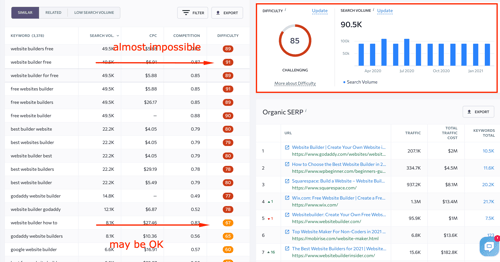
Avoiding keyword cannibalization
Sometimes, there may appear pages that are both ranked for the same keyword on your SaaS site. Or, you run an ads campaign and invest in SEO also for the same keywords. When some of your pages are ranked for the same keyword, there are three different scenarios, and all of them are not beneficial for you:
- Search engines may think that you are spamming your site and search results with one keyword. This will result in a decrease in your overall ranking.
- Your site will compete with itself for rankings, traffic, and conversions, and Google may rank higher on the non-target page.
- Google may decide that none of your competing pages correspond to any specific intent and not show them at all for that keyword.
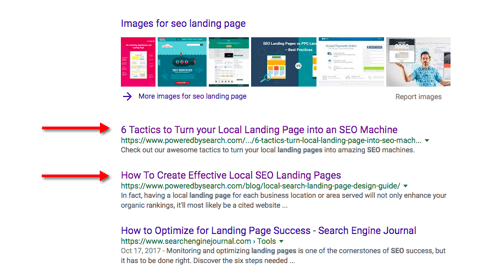
So, to make sure that keyword cannibalization is not your case, it’s better to make on-page SEO audits and remember the basic rule of SEO:
one page = one target keyword
Getting backlinks gradually
Backlinks have a direct impact on a site’s ranking. The rule is the more reliable sources that link to your site, the better. However, link building should be gradual. It is also necessary to carefully select donors because, in 2021, the quality of the inbound links matters more than quantity.
The main metrics to look at when selecting sites to place backlinks for SaaS products are:
- Domain trust – it should be 50 at least;
- Niche relevance;
- Backlinks that the donor receives and its dynamics;
- Whether the donor puts the “nofollow” or “sponsored” tags, etc.
The Majestic tool may help to analyze your existing backlinks and make sure you are not losing them. Also, it’s possible to analyze your competitors’ backlinks to find effective potential donors.
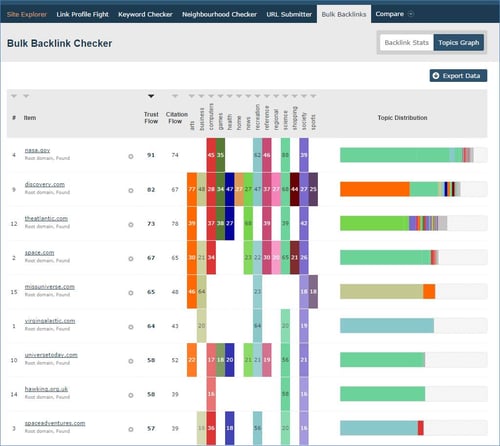
Being prepared for negative SEO
If you’re running a SaaS business, it’s better to be prepared that your competitors may not play nice and use negative SEO to overcome you. Negative SEO is using different unethical and black hat techniques to lower competitor’s rankings in search results. There are lots of such practices, including:
- Paying for spammy links pointing to your domain;
- Ordering bad reviews to influence rating in the SERP;
- Faking social signals;
- Link farms and PBNs (private blog networks);
- Copying your content;
- Excluding your pages from the index (for example, by hacking your robots.txt file).
One of the most popular negative SEO tactics is to order hundreds of backlinks from pharma, adult, free downloads, and other trash websites. One day, your SEO specialist may wake up and see that your site has many links from absolutely not trusted sites, and it will look like this:
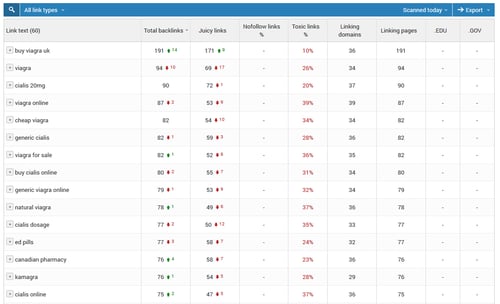
To prevent this from happening, it’s advised to constantly audit your website and carefully check the backlinks you receive. If your SEO notices links from unreliable sites that you disagreed with, the usual practice is to write to the owners and ask them to remove the links. Otherwise, they will pretty much ruin your reputation in the eyes of search engines.
In addition, the SE Ranking Backlink Checker tool will help to track new backlinks, their anchors, and domain trust.

Optimizing your content for voice search
Voice search is now a top trend. Right now, almost half of Internet users aged 16 to 64 already use it to search for something. While one may think that voice search is only used on the go or when the user is very busy with something, many respondents note that they are looking for something this way simply when they are at home alone or with friends, or in the office.
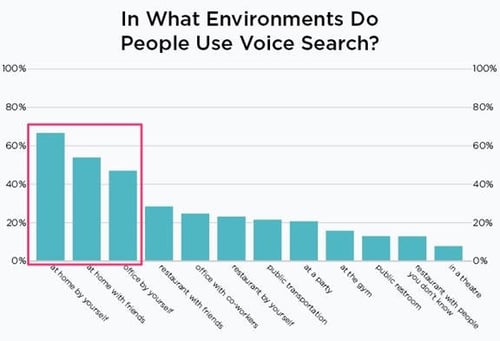
So, voice search is now far more than just sudden and urgent searches when someone’s hands are full. If you want to get the advantage of this trend, you should optimize your content and website for voice search. Here are some practices on how to do that:
- Collecting long-tail and low-frequency keywords;
- Trying queries written in simple language;
- Using words like “how,” “when,” “how-to” and give answers in the first 29 words;
- Using an SSL certificate, implement AMP and Turbo Pages;
- Adding a FAQ section to your site;
- Using markup (subheadings, bullet lists, etc.).
Segmenting customers
You may target B2B, B2C, or even both in your SaaS business, but it’s crucial to fully understand which markets you want to cover when coming up with your marketing and SEO strategy. So, it’s better to mind these differences:
- The needs of B2B clients are usually more complex because your SaaS solution is just a part of a more extensive process.
- Time spent before the final decision is also more for B2B clients since it involves a group of people, not just one person, like in the B2C segment.
- B2C customers are more emotional in the buying process.
- B2B customers are easier to target for SaaS companies and bring higher revenue.
- The buying cycle is shorter for B2C clients.
It’s crucial to understand who your customers are (enterprises or individuals) before implementing any changes to your marketing plan.
Based on whether your target customers are B2B or B2C, your marketing team can prepare better content, pick more effective keywords according to user intents, and get a higher CTR and result in conversions.
Summary
Growing your SaaS company using a channel like SEO can serve as the source of (almost) free and hot leads. However, in 2021, it’s not enough to simply collect keywords and insert them throughout the texts.
Your marketing team must constantly update your website for higher conversions and revenues, mind technical SEO issues, and work on usability. With our guide, a bit of patience, and a solution to get the most of your marketing metrics, your company will be primed for organic growth.


